

Within the Law (1923) Joseph M. Schenck Productions/First National. Produced by Joseph M. Schenck. Directed by Frank Lloyd. Adaptation by Frances Marion. Photography by Tony Gaudio. Edited by Hal Kern. Art direction by Stephan Goosson. Gowns, Walter Israel. Cast: Norma Talmadge, Lew Cody, Jack Mulhall, Eileen Percy, Joseph Kilgour, Lincoln Plummer, Thomas Ricketts, Ward Crane, Catherine Murphy, De Witt Gennings, Lionel Belmore, Eddie Boland. 8 reels. Copies of this film are held by the Library of Congress (35 mm., some deterioration), and Gosfilmofond of Russia (unconfirmed)
Within the Law is available on video from Kino
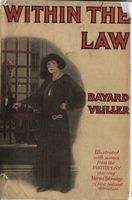 |
Dust Jacket |  |
Got her? Of course we got her. |
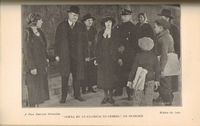 |
"She'll be an example to others," he snarled | 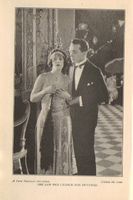 |
She saw her chance for revenge. |
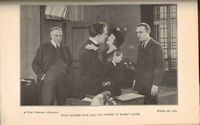 |
Dick Gilder now had no doubt of Mary's love. |
First National release starring Norma Talmadge, presented by Joseph M. Schenck. A screen adaptation of Bayard Vieller's play of the same title by Frances Marion, directed by Frank Lloyd. Shown at the Stand, New York, week April 20, 1923. Time, 81 min.
| Mary Turner | Norma Talmadge |
| Joe Garson | Lew Cody |
| Dick Gilder | Jack Mulhall |
| Aggie Lynch | Eileen Percy |
| Edward Gilder | Joseph Kilgour |
| Demarest | Arthur S. Hull |
| Helen Morris | Helen Ferguson |
| Cassidy | Lincoln Plummer |
| General Hastings | Thomas Ricketts |
| Irwin | Lionel Belmore |
| English Eddie | Warde Crance [i.e. Crane] |
| Darcy | Eddie Boland |
| Gilder's Secretary | Catherine Murphy |
| Burke | DeWitt Jennings |
This the second time that a screen version of the Bayard Vellier play, "Within the Law," has been made. The first was turned out by Vitagraph about six years ago, with Alice Joyce in the principal role. On this occasion Joseph M. Schenck is the sponsor for the picture Norma Talmadge is starred in. The question is, Will Miss Talmadge pull sufficiently at the box office to overcome the fact that a number of people have previously seen the picture? At the Strand Sunday afternoon any casual observer would have immediately answered, "Yes." But any one who watches the Strand business closely would wonder, for at the performance that started at 4 p.m. there were plenty of seats available, and from then on until 5:45, when the picture ended, there were no standees at the back of the house. That isn't the regular story at the Strand, but perhaps the fact that daylight saving for the summer became effective at 2 a.m. Sunday may have accounted for this to a certain extent, for the majority of the people in the big town forgot to change their watches in accordance with the law.
This version of "Within the Law" is particularly well done, and Norma Talmadge is a particularly effective Mary Turner, while Eileen Percy is admirable as Aggie Lynch, but much of Aggie's effectiveness was in her flip speeches, and these to a great extent were of necessity omitted on the screen. However, there is a little fault to find with the fact that Lew Cody was chosen as Joe Carson [sic]. Cody is far too well identified to the fan mind as a heavy to have him accepted as a heroic crook figure. It looked as though the Strand audience was waiting at any moment to see him do an about face in his role and try to knock off the hero. Incidentally Jack Mulhall was all that could be desired as the younger Gilder.
The cast supporting these principal characters is a lengthy one and fairly bristles with names that are well known on stage and screen, and this should be an asset to the picture.
"Within the Law"
Intensely Gripping Drama Based on Highly Successful Stage Play is Norma Talmadge's Latest
Reviewed by C.S. Sewell
After achieving an enviable record as a stage play, "Within the Law" has reached the screen via First National as a starring vehicle for Norma Talmadge. In this form it promises to duplicate its stage success. The story is an unusually absorbing one, rich in human interest. Norma Talmadge has never been provided with a more congenial role. As with all her pictures, it has been produced with an apparent disregard for expense. The star has been surrounded by an unusually fine cast. The theme is out of the ordinary and the development and direction are superb. All of these points combine to make "Within the Law" a production that grips you and rivets your attention from the first flash to the final fade-out. As a result it should prove a tremendous box-office attraction.
The story deals with a girl who, working in a department store at starvation wages, is railroaded to prison for a theft she did not commit, in striking contrast to the abject apology of the store owner in the case of a wealthy woman who is a "kleptomaniac." Such intense sympathy is aroused for the girl that when she has served her term and in furtherance of her idea of revenge she adopts a shady method of achieving prosperity, you feel that while her actions are far from ideal they are intensely human. Even after love for her victim's son steps in, she seeks to fight it down, and in an intense struggle with herself carries on with her scheme of revenge.
The title of the picture is derived from the fact that, although her schemes are shady, she always keeps within the law. For instance, when she and a girl friend resort to what appears to be blackmailing of wealthy men by threats of breach of promise suits, the negotiations are kept within the law by being conducted through skilled attorneys.
A very interesting angle to the production is the showing of the clever methods adopted by the police official to ferret out the murderer of his stool pigeon and the battle of wits between Norma and the representatives of the law.
Norma Talmadge is excellent throughout the production. Next in interest is Lew Cody in a role that is different from his usual run. This time, though he is cast as a crook, he proves a true friend of Norma and arouses your sympathy when he gives himself up for her sake. Jack Mulhall gives a thoroughly satisfactory performance in the role opposite the star; Joseph Kilgour is a fine type for the department store owner, and DeWitt Jennings, who played the same role on the stage, is excellent as the police inspector. Eileen Percy and, in fact, all the other members of the supporting cast give a good account of themselves and help to make the production a well-balanced whole.
Cast
| Mary Turner | Norma Talmadge |
| Joe Garson | Lew Cody |
| Dick Gilder | Jack Mulhall |
| Aggie Lynch | Eileen Percy |
| Edward Gilder | Joseph Kilgour |
| Demarest | Arthur S. Hull |
| Helen Morris | Helen Ferguson |
| Cassidy | Lincoln Plummer |
| General Hastings | Thomas Ricketts |
| Irwin | Lionel Belmore |
| English Eddie | Warde Crane |
| Darcy | Eddie Boland |
| Gilder's Secretary | Catherine Murphy |
| Burke | DeWitt Jennings |
Based on a play by Bayard Veiller.
Adapted by Frances Marion.
Directed by Frank Lloyd.
Photographed by Tony Gaudio.
Length, 8,034 feet.
Story
Mary Turner, working at starvation wages in a department store, is sent to prison for a theft she did not commit. She vows to get even with the store owner, Gilder, and on her return from prison, finding avenues of honorable employment closed to her, she pals with another girl, and together they achieve prosperity by beguiling elderly men of wealth and threatening them with breach of promise suits.
When an opportunity comes for her to meet Gilder's son she grasps it, and before long he falls in love with her and proposes. She accepts, and though she is beginning to return his love, she keeps up her plan of revenge and marries him. She then reveals her identity to old Gilder. To get rid of her the police frame a burglary. Joe Garson, who has befriended her, falls for the scheme, which, however, misses fire, but in the melee Joe discovers he has been framed and kills English Eddie, the stool pigeon. Mary, to further complete her revenge, accuses her husband of the murder, and she and her husband are arrested. Clever police methods cause Joe to confess in order to save Mary. The girl who had stolen the goods for which Mary was sent to prison admits the theft. Mary gives way to her real love for young Gilder.
The Shadow Stage, by Frederick James Smith
July, 1923, p. 67
Bayard Veiller's melodrama, "Within the Law," has been done before on the screen. This story of the innocent shopgirl, railroaded to prison, who starts out to wreak vengeance upon those who have wronged her, always keeping inside the law, was highly effective behind the footlights. We have forgotten Alice Joyce's playing of Mary Turner in the earlier celluloid version but Norma Talmadge's performance in this adaptation leaves us cold. Miss Talmadge, like many of our established stars, seems afraid to act. Here she seems more concerned with photographic values than with making Mary Turner live. Indeed, her conception borders on the saccharine. Oppressed by the police or plotting her enemies' ruin, her Mary Turner is just too sweet for anything. And never are you allowed to forget that she is big hearted and a perfect lady.
The National Guide to Motion Pictures: Photoplay's selection of the six best pictures of the month
July, 1923, p. 68
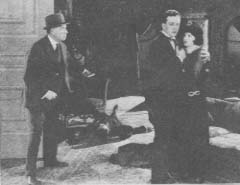 |
WITHIN THE LAW--First National. This production of Bayard Veiller's melodrama has everything save inspiration. The production is expensive, the cast is a series of big names, the direction is adequate. And yet the melodrama lacks something vital. We put this to Norma Talmadge's playing of Mary Turner. Miss Talmadge seems afraid to act, not an uncommon ailment these days among our stars. There is hardly a suggestion of the emotional Mary Turner of the stage originator, Jane Cowl. This Mary gives you no doubt about her sweetness, her dignity, and her ability to look photographically smart. What the screen needs is something to upset our stellar restraint. Actually the best acting of "Within the Law" is that of Lew Cody as the crook Joe Garson, and Helen Ferguson in her brief moments as a shop girl.
A Cruel and Heartless Magazine (letter, October 1923, p. 18)
EDITOR PHOTOPLAY MAGAZINE
Dear Sir: Our leading luminaries, says PHOTOPLAY, seem afraid to act--in their current vehicles at least. Perhaps they all had Spring fever. For the pictures we are seeing now are, I imagine, films that were made in the Spring, tra la! PHOTOPLAY is right. Pictures were never more dull or uninteresting than they have been for the past month or two. It is enough to discourage the most optimistic fan. The producers are saving their best bets for the fall season and, in the meanwhile, we suffer.
However, PHOTOPLAY is most cruel and heartless to condemn Norma Talmadge, the incomparable, and label her "afraid to act." Why it was the very quietness of her performance in "Within the Law" that was praiseworthy. No ranting, no wild gestures, no heaving bosom, nor overflowing emotion! But then, no Norma fan like myself would be capable of viewing her work in the calm, impersonal manner of the hardened critic.
Why do they do it (Blooper section, Oct. 1923, p. 118)
MAYBE HE HAD TWO
In the picture, "Within the Law," Norma Talmadge as Mary Turner, is seen jumping into the river, attempting suicide. Joe Garson comes to the rescue. He throws off his overcoat--dives in, and saves her. The next scene shows him leaving the elevator of a hotel escorting Mary to a girl friend's room--he has no overcoat--and, after seeing that Mary will be cared for, he picks up his overcoat and leaves.
Honorable Mention section
"WITHIN THE LAW"
Directed by Frank Lloyd.--Adapted from Bayard Veiller's play.--Produced by Joseph M. Schenck.--Distributed by First National.--Released April, 1923.--Cast: Norma Talmadge, Lew Cody, Jack Mulhall, Joseph Kilgour, Helen Ferguson, Eileen Percy and Ward Crane.
Norma Talmadge has a fine flair for polite melodrama and "Within the Law" was an ideal medium for the display of this talent. The story of the innocent shop-girl who was railroaded to prison, and who subsequently wreaked revenge upon her oppressors, was meat for Miss Talmadge.
"Within the Law" was not so effective on the screen as it had been on the stage, but it was well above the average for that. Lew Cody did splendid work as the sympathetic villain, and Frank Lloyd's direction was consistently efficient.
Original comments after viewing on a Steenbeck at the Library of Congress, probably around 1999.
Update, Feb. 2010: Within the Law is now available on video from Kino, with a piano score by Makia Matsumura. It's paired with Kiki on the same disc
Within the Law was Talmadge's last silent crime drama, a bizarre variation of the common woman's film plot device of the working girl marrying the boss. This was its second of four film incarnations (the 1932 version with Joan Crawford was entitled Paid). The poor shopgirl, unable to find a job after prison, decides to take her vengeance on society while staying within the law. We next see her several years later armed with a smart lawyer, an expensive house, and a beautiful and elegant wardrobe. She is the head of a blackmailing ring operating legally under the cloak of breach of promise suits. We see that she is quite efficient in her business, but from her clothes and demeanor we also see that she is a lady despite her shopgirl origins, particularly when compared with her lower class associate, who still dresses badly and sticks her chewing gum on chairs in expensive restaurants. Thus, she is able to marry her former employer's son as her revenge. The film leads the audience to an interesting conclusion: the police are corrupt and the greed and stupidity of underclass criminals dooms them to failure, but follow the example of the ruling class and conduct only legal outrages, and be rewarded with wealth, a stunning wardrobe, and marriage to the boss's son.
It is interesting to compare the differing interpretations of Talmadge and Crawford in the same part. Crawford is more convincing as a woman angry enough to take such a revenge and with the street smarts to do it. Talmadge is more bewildered and terrified in the courtroom scene at the beginning of the film, but low-key for the rest of the film, while giving the character enough sentiment to believably fall in love with her intended victim. Of course, the scenarios differ in several particulars along those same lines--more cynical in the Crawford version while trying to instill sympathy for the character in Talmadge version, and are fairly typical of the differences between women's films in the 20s and the 30s. The other players are excellent as well, particularly Lew Cody in an unusual sympathetic part. An interesting contrast to these two versions is the Ruth Hussey version of 1939, a post-code version in which she continually berates herself for being such a bad girl.
Print viewed: 35mm from the Library of Congress, some jumpy footage at the end of reel 2.
Comments after Pordenone screening, 2022.
Since this one is on video, i've probably seen it more than any of Norma's other films, and it still stands up to repeated viewing. The audience seemed to enjoy it as well, and the big screen wes especially good for seeing Norma's stylish gowns.
Last revised, December 14, 2022